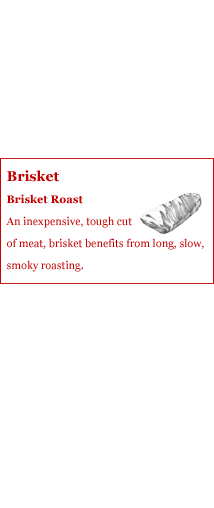Grilling: Beef
About Beef
The sight and aroma of a steak sizzling over a bed of glowing coals may be a high point of summer. In fact, many knowledgeable cooks insist there is no better way to cook most cuts of beef than over a smoky, direct- or indirect-heat fire.
Cuts for Grilling
The best beef cuts for grilling come from the less exercised areas of the steer, the short loin, sirloin and rib sections. Other cuts of meat can also be grilled successfully, but they may need a marinade or long, slow cooking to make them more tender.
Shopping for Beef
With the exception of flank, skirt and hanger steaks, which come from the belly of the steer, steaks are cut from the back of the animal, usually from the loin and rib portions. Most steaks are tender enough to grill over direct heat, which creates a caramelized crust and juicy interior. The less tender steaks from the belly tend to have a "beefier" flavor than those from the less used muscles along the back; these steaks are much more tender if marinated for several hours before grilling.
When choosing steaks, look for bright red meat with light marbling (internal fat), a fine texture and nearly white outer fat. The exterior fat should be minimal, although you can always trim it before grilling. The more marbling a steak has, the more tender and juicy the beef will be. Look for many small deposits of fat, which resemble the light streaks in a dark marble floor, rather than a few large globs.
Use the same criteria for choosing ribs or meat for kabobs: opt for vibrant red meat with good marbling. Pass up beef that is turning brown or has large pieces of fat. For the best results with kabobs, choose a large piece of meat and cut it into cubes just before grilling.
When selecting ground (minced) beef, seek out a nice piece of chuck with 15 to 20 percent fat, ask the butcher to grind it for you and then cook it the same day. Better yet, if you have access to a meat grinder, grind it yourself just before you grill. Not only will this create a more flavorful burger, but it also reduces the likelihood of harmful bacteria in your ground beef. When choosing beef for your burgers, don't skimp on the fat. The right amount of fat in the meat will create a juicy and flavorful burger that holds together well.
When shopping for roasts, look for well-trimmed external fat and a good amount of internal marbling. The meat should appear slightly moist and be a good, even red color. Smell the meat to make sure that it has a clean, fresh aroma with no off odor. Most large cuts will appear fine-grained, with the exception of brisket and tri-tip, which will have a coarser texture.
Whether buying steaks, burgers, roasts or ribs, pass up meat that is wet or sticky and has purple discoloration. Also avoid meat with yellow or brown fat or any meat that smells stale, sour or otherwise unpleasant. For the best quality beef, cultivate a relationship with a reliable, high-volume butcher who will cut meats to your specifications.
Preparing Beef for Grilling
Prior to cooking beef, trim off most of the external fat and discard it. Internal fat or marbling promotes tenderness and flavor, but external fat causes flare-ups as it melts and drips into the fire.
Beef should be salted before it goes on the grill, which is contrary to the old thinking that salting before cooking draws out juices and produces dried-out meat. Be prepared to salt beef more than you think necessary. A generous sprinkling will bring out the true flavor of the meat and keep it nice and juicy.
Testing Beef for Doneness
To judge the doneness of grilled beef visually, cut into the thickest part. Rare beef will look reddish in the center, and medium will have a trace of pink. Cooking beef beyond medium causes it to dry out and become tough.
Burgers are the exception; for safety's sake, they should be cooked at least to medium (145°F or 63°C), and many health experts say it is wisest to cook them to at least medium-well (160°F or 71°C).
All beef should rest for 3 to 15 minutes after grilling, depending on size, to allow the juices to redistribute throughout the meat, thus ensuring juiciness and full flavor. The internal temperature could rise as much as 5° to 10°F (3° to 6°C) as the meat sits. Keep this in mind and remove beef from the grill when it is some degrees shy of the desired temperature. You can always cook beef a little more if needed.
Adapted from Williams Sonoma Essentials of Grilling, Denis Kelly, Melanie Barnard, Barbara Grunes & Michael McLaughlin, (Oxmoor House, 2006).















